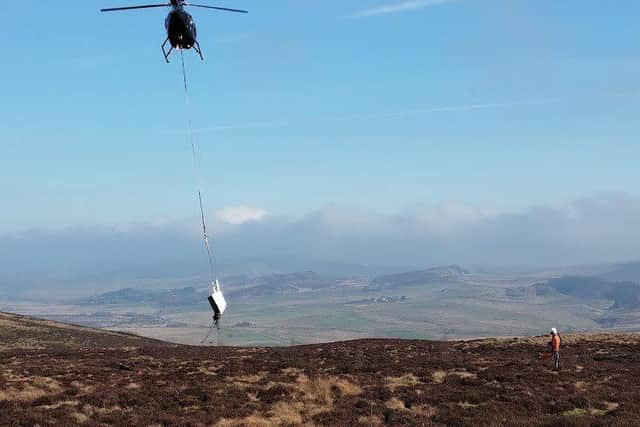Works underway to restore wildfire scarred landscape
and live on Freeview channel 276
Moors for the Future Partnership scientific research of the aftermath revealed a 53mm depth of peat was lost to the fire. That peat would have taken over 50 years to form from vegetation being preserved in waterlogged, acidic conditions of blanket bog. Over 11,000 tonnes of carbon dioxide was released back into the atmosphere as a direct result of the fire, the equivalent carbon loss to running 1,426 homes for a year.
Moors for the Future Partnership has begun extensive works on this scarred landscape. These works include the blocking of gullies eroded by water using stone and coir log dams made from coconut fibre, the re-wetting of the degrading and drying peat surface using sphagnum moss planting, diversifying the vegetation and planting of a selection of native plants and the stabilising and revegetating of remaining bare peat from the 2018 fire.
Advertisement
Hide AdAdvertisement
Hide AdThe land area under restoration is owned by Peak District National Park Authority and is managed by Staffordshire Wildlife Trust. Water-retaining peat bunds built by the Trust prior to the 2018 wildfire illustrate how hydrologically restored areas can resist fire, as survey photography shows wet areas survived the destruction. The local community, visitors and moorland enthusiasts can get involved in hands on restoration work in the Moors for the Future Partnership volunteer sphagnum moss planting scheme. Sphagnum moss is an essential carbon store, accumulating over time to create new layers of peat. It is able to absorb up to 20 times its own weight in water, protecting and maintaining the wetness of the peat underneath and holding peak water flow on the hills. This small moss will help to return this once bleak landscape back to life, providing a home for a rich selection of moorland species of plants, insects, birds and mammals.


The Roaches restoration is part of a wider programme across the Peak District National Park, which includes Bamford, Goyt Valley and the Roaches, funded by Natural England. The Nature for Climate Peatland Grant Scheme (NCPGS) provides funding to restore peatlands in the uplands and lowlands of England. This important work also attracted match funding from United Utilities, Severn Trent, National Trust, Staffordshire Wildlife Trust and BMC Access and Conservation Trust.
Jim Randle, Conservation Works Officer at Moors for the Future Partnership, said “It can be shocking when you see the immediate impact of a serious wildfire. Works we are carrying out over the next 18 months will continue to slow the flow of water off the upland, improving the hydrology and biodiversity of the site, bringing it closer to the condition it was in before the 2018 fire and supporting the formation of a healthy and peat-forming environment.”
Jon Rowe from Staffordshire Wildlife Trust said: “Though it was heart-breaking to see the level of destruction from the fire 6 years ago, it’s been an inspirational journey towards recovery. It’s important that people do realise that just one careless moment with a campfire, barbeque or cigarette can cause so much damage and that’s why we are keen to get the message out about wildfire awareness and encourage people to enjoy the moors but also help to protect them."